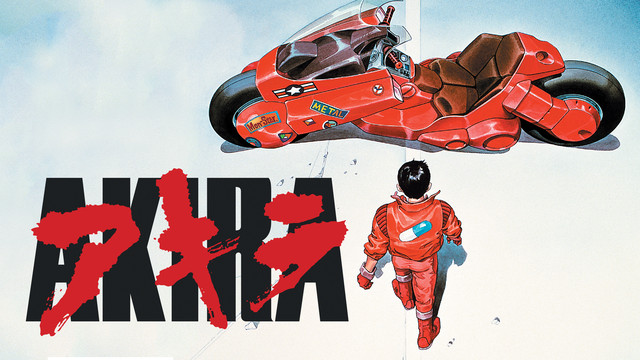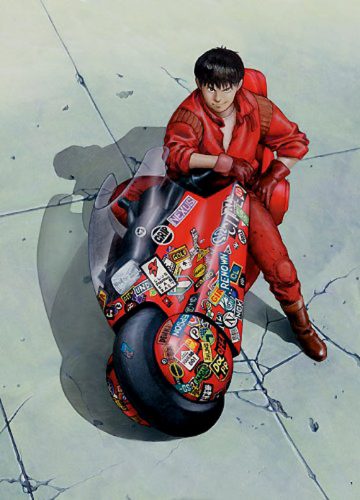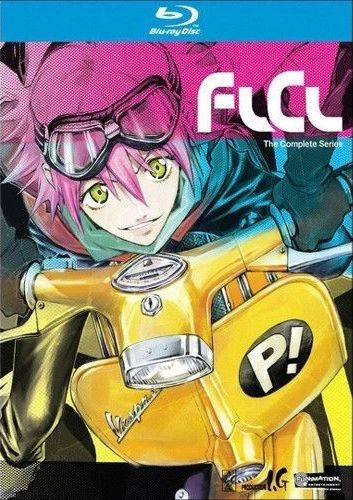

Vroom! Today, Honey’s is bringing you a fast-paced article covering some of our favorite motorcycles, scooters, and otherwise powered, non-car vehicles of similar variety as well as touching on cycle culture in Japan. Hop on, let’s ride!
Shotaro Kaneda's Bike from Akira

Arguably the most recognizable motorcycle in all of anime, Kaneda’s bike has been etched into the minds of anime fans new and old thanks to that frequently-referenced slide animation and the iconic, minimalist movie poster. Symbolizing Kaneda’s power and leadership of the gang, this ultra-high-performance motorcycle’s sleek design, intense red color, and amazing effects—particularly the distinctive green static electricity coming off the front tire and engine sounds made by splicing recordings of a MiG-21 fighter jet and a 1927 Harley-Davidson—make it stand out. Smaller details like the various corporate logos of Canon, Citizen, Shoei, etc. add further character and the film’s amazing production values in animation really bring this bike to life!
Hermes from Kino no Tabi (Kino’s Journey)
Finally a motorcycle with a personality! Quite literally in this case as Kino’s companion and vehicle Hermes has not only intelligence but can even speak, often providing pessimistically realist commentary on the state of affairs along with frequent complaints and occasional poorly explained technical information and misremembered quotes. As something of a comic relief character, Hermes and his interactions with Kino are a highlight of the series. Hermes’ design is based on the real-world Brough Superior SS100 motorcycle with a seriously retro-cool aesthetic. These custom-made British cycles built from 1925–1940 were used by T. E. Lawrence, aka Lawrence of Arabia, whose his death in an accident prompted research into creating safety helmets. They were also the first production motorcycles capable of reaching 100 mph (160 km/h) and remain highly sought-after collection pieces.
Haruko Haruhara’s Vespa Scooter from FLCL
While scooters of various sorts have been featured in many anime series, and are a very common sight in Japan, maniac alien investigator Haruko Haruhara’s vehicle of choice, a bright yellow 1965 Vespa Super Sport 180, is certainly the most memorable. Very emblematic of Haruko’s character and matching her otherworldly eye color, with its unpredictable movements, supernatural speed, ability to fly, and perhaps the initially inconsistent model it features prominently in the series, it embodies the chaotic coolness that made the OVA series so fun to watch. Similar to Kaneda’s bike, details like the iconic P! sticker (referencing the pillows, who provided the series’ music) and the 56-56 license plate number (pronounced goro-goro in Japanese which is an onomatopoeia that can be used for thundering, purring, stomach grumbling, or lazing about) further adds to its connection to FLCL and Haruko’s character. Likewise, the stop-motion photo sequence in the ED using a real Vespa cements this scooter in our anime memories.
A Little Bit on Bikes in Japan and Bosozoku
As alluded to previously, motorcycles and scooters are quite popular in Japan and Japanese manufacturers like Honda, Yamaha, Suzuki, and Kawasaki have been dominant forces in the industry worldwide for decades. In fact, the Honda Super Cub is the most produced motor vehicle in all of history with over 100 million units. Small engine vehicles are popular for their usefulness and fuel economy in large Japanese cities while high-end performance machines like Kawasaki’s Ninja H2R are the fastest and most powerful production motorcycles on the market, capable of reaching 250 mph (400 km/h)! Japan is also famous for its Bosozoku (literally meaning “running out of control tribe”) motorcycle gangs which started in the 1950s and peaked in the 1980s and 1990s which the Capsules and Clown gangs in Akira clearly took inspiration from. Taking influence from other subcultures like the mods of Britain and American greasers and bikers, Japanese motorcycle gangs are known for their street fashion boilersuits and leather jackets emblazoned with huge kanji characters and other symbols, pompadour hairstyles, long hachimaki headbands, etc. Bosozoku are probably most famous for their highly customized motorcycles combining elements of American choppers and British café racers with elongated seats, squeezing the handlebars inwards along with other modifications, and finished with striking paint jobs and stickers. It should be noted that while their numbers have decreased significantly in modern times, some of these gangs are legitimately violent and engage in yakuza-like criminal activity.
Final Thoughts

There are certainly many more motorcycles worth mentioning, like Celty’s shadowy black Shooter from Durarara, Hane Sakura’s Honda CB400 Super Four from Bakuon!! and edge cases like the half-track Kettenkrad vehicle in Shoujo Shuumatsu Ryokou (Girls' Last Tour), but we’ll leave you here, for now at least, to preserve our speed. Let us know your own favorite cycles in anime in the comments section below and stick around Honey’s for more of all things awesome, anime motorcycles and otherwise! See ya~!
[recommendedPost post_id='105267' url='' title='' img='' class='' widget_title='']
Add Comments